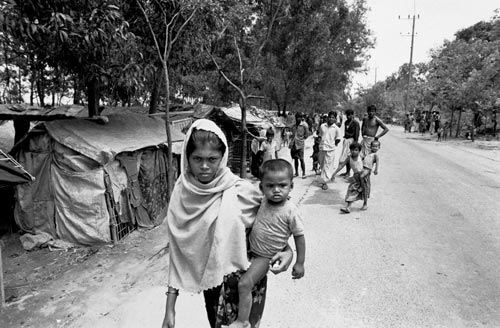Last week, militants staged a series of attacks in Myanmar’s troubled Rakhine region. Armed with machetes, sticks, improvised explosive devices and a few small firearms about 150 men raided 30 police posts and one army base in the early hours of 25 August. They killed 10 policemen, one army soldier and one state official. At least 80 insurgents lost their lives.
Myanmar’s security forces have since conducted an extensive counteroffensive against what its commander-in-chief describes to be “extremist Bengali terrorists”, in reference to the government’s preferred label for those who are otherwise known as the Rohingya minority. According to the United Nation, at least 300,000 Rohingya civilians have since been fleeing the violence. Aung San Suu Kyi has made it clear that she holds the insurgents responsible for what is happening. Allying firmly with the military, her office officially designated the militants – who call themselves Arakan Rohingya Salvation Army (ARSA) – as “terrorists”. Issuing a warning to the media against writing in support of the group, it ordered journalists to use the word “terrorists” instead of “insurgents”.
From an academic perspective, “terrorism” is a fuzzy and often overstretched concept. This notwithstanding, students of political violence have long attempted to distinguish between “terrorist” and “insurgent” violence. One frequently mentioned distinction seems particularly important in the context of Rakhine. While insurgents and terrorists are both fighting for political aims with violent means, their main means and targets of violence are different. Insurgents seek to effectuate political change by targeting the state and its agents. They commonly do so by means of guerilla warfare. Terrorists, in contrast, intentionally target civilians in order to achieve political goals and strategies. The direct targets of terrorism (civilians) serve as “message generators” in the process of “violence-based communication” with the main target of terrorism (e.g., the state or society). Insurgents then can also be terrorists, if using systematic violence against civilians, but do not necessarily have to be.
Considering this, the attacks of Rohingya militants on police and army units look more like insurgent violence than terrorist violence. To be sure, the Myanmar government has accused the ARSA to target civilians. For anyone familiar with the conflict in Rakhine it also comes to no surprise that social media is full with graphic images of mutilated civilians. As the Myanmar government has banned any independent reporting in the affected regions of northern Rakhine State none of this verifiable. It is beyond doubt that violence against civilians has been committed by all sides in the protracted communal conflict between the Rakhine and Rohingya people. Surely, ARSA does not have clean hands either. From what we know, however, ARSA militants have hitherto focused their attacks on the state’s security personnel.
This stands in contrast to Myanmar’s security forces themselves. Again, independent monitoring is banned but all available evidence suggests that military units are indiscriminately targeting Rohingya civilians. The exodus of Rohingya arriving in neighboring Bangladesh speaks of horrific violence including ethnic cleansing and massacres at the hands of the military. Satellite images reveal that villages are being burned down systematically. That the military has a long track record of indiscriminately targeting civilians in their offensives in ethnic minority regions across the country is well-documented. After the forerunner of the ARSA staged its first attacks on border posts in October of last year, state forces have reportedly committed mass killings and gang rapes of Rohingya civilians in six month-long “clearing operations” that similarly sent 87,000 people fleeing to neighboring Bangladesh. According to the UN Office of the High Commissioner for Human Rights, these actions “very likely” amount to crimes against humanity and possibly ethnic cleansing. It thus seems that the state is responsible for most of the terror against civilians in Rakhine State.
Against this background, it might seem puzzling that Nobel Peace Prize laureate Aung San Suu Kyi is so ardent at denouncing Rohingya militants as “terrorists”. For students of political violence it is not. To proscribe an armed group as “terrorists” is foremost a political act that serves powerful discursive functions, including the de-legitimization of the enemy and legitimization of extraordinary policy measures. Scholars have debated this at length with regards to the Western “war on terror”. In Myanmar, calling ARSA terrorists instead of insurgents serves similar functions. In fact, stressing the “terrorist” nature of Rohingya militants seems to be a clear attempt to embed the Rakhine conflict within a global “war on terror” narrative. Similar to Russia’s “war on terror” in Chechnya, this is meant to legitimize heavy-handed counterinsurgency practices, not least for the international community. Unsurprisingly, military spokesmen have been quick to emphasize the difficulty in distinguishing civilians from combatants in their fight against Rakhine “terrorism”.
Most importantly, the case of the ARSA illustrates how authorities can create hierarchies of legitimate resistance by distinguishing between somewhat legitimate “insurgents” and completely illegitimate “terrorists”. This is particularly interesting in the context of a country that is home to a dazzling array of ethnonational insurgency movements. In this respect, it is noteworthy that many members of Myanmar’s established ethnic armed groups, such as the Kachin Independence Organisation (KIO), do not want to be called “insurgents” either. They prefer the term “armed ethnic organizations” for their movements instead. Myanmar’s government uses a variety of expressions to refer to armed opposition groups. For movements that signed ceasefire agreements it often uses “ethnic armed organisations”. The ones that continue with armed struggle are often condemned as “insurgents”. In denying the Rohingya uprising the second-best label of “insurgents” and calling them “terrorists” instead, Aung San Suu Kyi placed them firmly at the bottom of legitimate resistance in Myanmar.
This post was first published on Political Violence @ a Glance: https://politicalviolenceataglance.org/2017/09/05/rohingya-terrorists-and-the-hierarchies-of-legitimate-resistance-in-myanmar/
Dr David Brenner is Lecturer in International Relations at the University of Surrey

